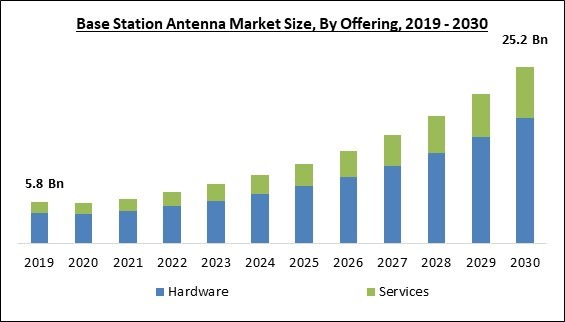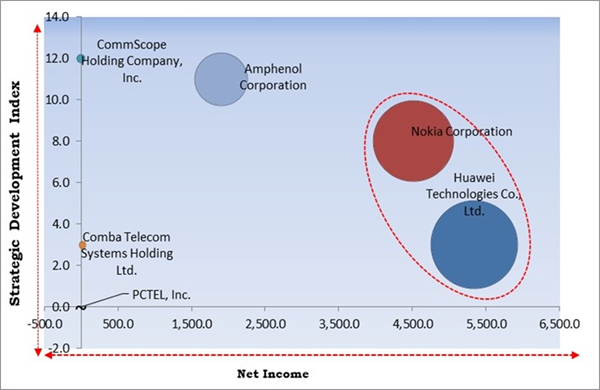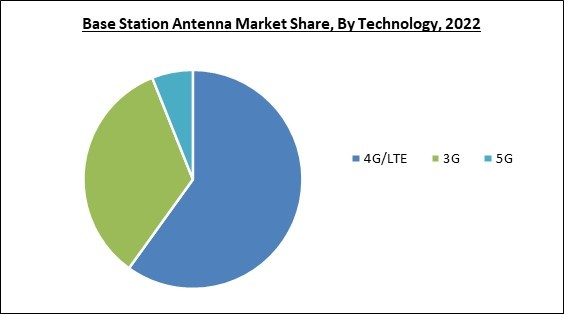The Global Base Station Antenna Market size is expected to reach $25.2 billion by 2030, rising at a market growth of 17.0% CAGR during the forecast period.
Due to the growing need for greater connectivity as well as capacity in smart transportation systems, the intelligent transport segment attained a significant revenue of $597.1 million in the market in 2022. To deliver effective services, these antennas improve the connectivity and functionality of connected automobiles. Meanwhile, the Government of Canada aimed to offer all Canadians with access to quick, dependable, and reasonably priced mobile and Internet services. Due to constant efforts of the government and the adoption of 5G technology, which is driving demand for powerful these antennas in this region, the North America segment will acquire approximately 1/4thshare in the market in 2030.
The major strategies followed by the market participants are Product Launches as the key developmental strategy to keep pace with the changing demands of end users. For instance, In February, 2023, Comba Telecom Systems Holdings Limited Released Green Base Station Antenna product series to help operators around the world meet carbon neutrality requirements since green and low-carbon design elements are integrated throughout the whole product life cycle. Additionally, In January, 2023, CommScope revealed HomeVantage home networking to provide cutting-edge services and features that satisfy the demands of the worldwide market.
Based on the Analysis presented in the The Cardinal Matrix; Huawei Technologies Co., Ltd. and Nokia Corporation are the forerunners in the Market. In October, 2021, Huawei Investment & Holding Co., Ltd releases Eco-series antennas, to offer high-quality network coverage more affordable. Companies such as Amphenol Corporation, CommScope Holding Company, Inc., Comba Telecom Systems Holding Ltd. are some of the key innovators in the Market.
The market research report covers the analysis of key stake holders of the market. Key companies profiled in the report include Procom, CommScope Holding Company, Inc., Huawei Technologies Co., Ltd., Nokia Corporation, Amphenol Corporation, Comba Telecom Systems Holding Ltd., Baylin Technologies, Inc., Ace technologies Corporation, Rosenberger Hochfrequenztechnik GmbH and PCTEL, Inc.
Due to the growing need for greater connectivity as well as capacity in smart transportation systems, the intelligent transport segment attained a significant revenue of $597.1 million in the market in 2022. To deliver effective services, these antennas improve the connectivity and functionality of connected automobiles. Meanwhile, the Government of Canada aimed to offer all Canadians with access to quick, dependable, and reasonably priced mobile and Internet services. Due to constant efforts of the government and the adoption of 5G technology, which is driving demand for powerful these antennas in this region, the North America segment will acquire approximately 1/4thshare in the market in 2030.
The major strategies followed by the market participants are Product Launches as the key developmental strategy to keep pace with the changing demands of end users. For instance, In February, 2023, Comba Telecom Systems Holdings Limited Released Green Base Station Antenna product series to help operators around the world meet carbon neutrality requirements since green and low-carbon design elements are integrated throughout the whole product life cycle. Additionally, In January, 2023, CommScope revealed HomeVantage home networking to provide cutting-edge services and features that satisfy the demands of the worldwide market.
The Cardinal Matrix - Market Competition Analysis
Based on the Analysis presented in the The Cardinal Matrix; Huawei Technologies Co., Ltd. and Nokia Corporation are the forerunners in the Market. In October, 2021, Huawei Investment & Holding Co., Ltd releases Eco-series antennas, to offer high-quality network coverage more affordable. Companies such as Amphenol Corporation, CommScope Holding Company, Inc., Comba Telecom Systems Holding Ltd. are some of the key innovators in the Market.
Market Growth Factors
Implementation of smart antennas to enhance mobile communication infrastructure
The seamless data, voice, and control services provided by 4G and 5G technologies are supported by smart antennas' better wireless network capacity and coverage range. These antennas were developed as a viable technique to boost mobile communication efficiency. Utilizing the beamforming approach, smart antennas lower interference levels and increase the network operator's capacity. By expanding the system's user base and coverage, smart antennas enable the delivery of services of the highest caliber. As a result, more mobile communication providers are using smart antennas. Therefore, the market will rise in the coming years with these developments.Worldwide expansion of smart city initiatives
Intelligent security solutions are becoming increasingly necessary due to the Internet of Things and cutting-edge city projects. Furthermore, effective energy-management systems are highly regarded to guarantee accurate metering and minimize waste. In order to facilitate effective administration and monitoring, lower carbon emissions, and improve route planning and optimization, smart city transportation infrastructure supply is also being promoted. Many nations are currently making significant investments in technology to update their outdated infrastructure. For instance, the Indian government spent significant money transforming 100 existing cities into smart cities. These elements would thus create new growth opportunities for network connectivity in smart cities. As a result, this would hasten the market expansion for these antennas in the next years.Market Restraining Factors
Rising alertness of adverse health effects of RF radiation
For the wireless connections to be transmitted, the base station's network is crucial. These antennas are deployed to send and receive radio frequency signals from the linked devices. These radio waves are crucial to establish a wireless link for communication. Users' worries about the harmful effects of RF radiation from antennas, however, are mounting. The effects of base station RF radiation have been the subject of numerous medical studies during the past year. Epidemiological studies, animal studies, human volunteer studies, and in-vitro studies are just a few examples of medical research that are conducted. Therefore, more people and manufacturers are opposing the adoption of 5G, because of which the market share will likely suffer.Offering Outlook
Based on offering, the market is characterized into hardware and services. The services segment procured a considerable growth rate in the market in 2022. The rising demand for installation services is expected to propel the services category to impressive growth throughout the projection period. There is an increasing demand for expert services to ensure that these antennas are installed and integrated properly as network operators attempt to improve their infrastructure and increase their coverage. This covers services, including site surveys, testing, antenna installation, and optimization. For the best performance and dependability of base station antennas, managed service providers provide troubleshooting, proactive monitoring, and network administration.Hardware Outlook
On the basis of hardware, the market is classified into omni-directional antenna, sector antenna, multibeam & dipole antenna, small cell, and others. The omni-directional antenna segment acquired the largest revenue share in the market in 2022. Due to its capacity for greater coverage and superior signal strength, this market segment currently has a dominant position. In wireless access points, cellular base stations, and other communication applications, the omni-directional antenna is frequently employed.Technology Outlook
By technology, the market is divided into 3G, 4G/LTE, and 5G. The 4G/LTE segment garnered the maximum revenue share in the market in 2022. The ever-increasing need for higher frequencies and larger bandwidths to handle the burgeoning data traffic is a major reason for the segment's growth. Base station antennas that support 4G and LTE are essential in order to provide users with dependable and quick internet connectivity.Application Outlook
On the basis of application, the market is classified into mobile communication, intelligent transport, industrial IoT, smart city, military & defense, and others. The military and defense segment garnered a considerable growth rate in the market in 2022. One of the key factors propelling the segment's growth is the expanding need for strong and resilient base station antennas that can withstand challenging environments and perform in difficult circumstances. Antennas that withstand pressure, vibration, and environmental factors, including humidity, dust, and temperature variations, are typically required for military and defense applications.Provision Outlook
Based on provision, the market is segmented into urban, semi-urban, and rural. The urban segment acquired the highest revenue share in the market in 2022. One of the main drivers of the segment's growth is the expansion of small cell deployment in urban areas. To increase network capacity and coverage, small cells, such as picocells and microcells, are being put in crowded urban areas. Because they provide targeted coverage and unload traffic from macrocell networks, these small base station antennas contribute to reducing the high data demand in metropolitan areas while also enhancing network efficiency and user experience.Regional Outlook
Region wise, the market is analyzed across North America, Europe, Asia Pacific, and LAMEA. The Asia Pacific segment acquired the maximum revenue share in the antenna market in 2022. The need for these antennas in this region is anticipated to increase as 5G rollouts pick up in nations like South Korea, China, and Japan. Over the course of the forecast, China is anticipated to emerge as a prominent market. India is anticipated to become more well-known due to the quickly changing telecom sector and rising mobile user base. Similar to China, South Korea is also expanding significantly as a result of the growing attention being paid to 5G infrastructure.The market research report covers the analysis of key stake holders of the market. Key companies profiled in the report include Procom, CommScope Holding Company, Inc., Huawei Technologies Co., Ltd., Nokia Corporation, Amphenol Corporation, Comba Telecom Systems Holding Ltd., Baylin Technologies, Inc., Ace technologies Corporation, Rosenberger Hochfrequenztechnik GmbH and PCTEL, Inc.
Strategies Deployed in the Market
Partnerships, Collaborations, and Agreements:
- Mar-2023: Nokia joined hands with Radio Frequency Systems (RFS), a global designer and manufacturer of end-to-end wireless connectivity solutions. The collaboration aimed to deliver enhanced 5G base station capabilities.
- Jul-2022: CommScope teamed up with Microsoft, an American multinational computer technology corporation, to build a converged private wireless network solution. To increase operational effectiveness, The company utilized Microsoft's private MEC platform along with CBRS access points in its industrial innovation center.
»Product Launches and Product Expansions:
- Feb-2023: Comba Telecom Systems Holdings Limited Releases Green Base Station Antenna product series, powered by Helifeed Platform. Comba Telecom provides cutting-edge HelifeedTM Green Antennas to help operators around the world meet carbon neutrality requirements since green and low-carbon design elements are integrated throughout the whole product life cycle.
- Jan-2023: CommScope revealed HomeVantage home networking solutions, a portfolio of high-performance gateways. With the HomeVantage portfolio, service providers can streamline broadband deployment, successfully manage software applications, and shorten their time to market while providing cutting-edge services and features that satisfy the demands of the worldwide market.
- Oct-2021: Huawei Investment & Holding Co., Ltd releases Eco-series antennas. The series uses Huawei's Signal Direct Injection Feeding (SDIF) technology which ensures High energy efficiency and high gain, enabling operators to offer high-quality network coverage more affordable.
- Sep-2021: Amphenol Procom, a subsidiary of Amphenol Corporation, revealed PRO-DPBP 380-EXT, 2 x 6 resonator high-quality Duplex Band Pass filter, PRO-DPBP 380-400/410-430, Duplex Band-Pass Filter with 2 x 20 MHz bandwidth, and DPF 70/55 380-EXT, Duplex Filter.
- Mar-2021: CommScope unveiled new antenna solutions including C-Band Antennas, and CBRS Antennas to enable wireless operators to build their networks faster. The CommScope modular antenna will aid operators in easing the planning application process and reducing cell-site clutter, two issues that are undoubtedly key obstacles to the deployment of statewide 5G networks.
Acquisition and Mergers:
- Apr-2021: Amphenol Corporation acquired MTS Systems Corporation, a supplier of test systems and industrial position sensors. This acquisition would deliver the company's customers a broadened suite of innovative technologies in various markets. Additionally, this would result in the finding of new opportunities and growth in the electronic segment.
- Feb-2021: Amphenol Corporation completes the acquisition of Positronic, a provider of power and signal connectors. Through this acquisition, the consumers would be able to use a broad D-sub military/aerospace connector suite along with access to the upcoming innovative technologies.
Scope of the Study
By Offering
- Hardware
- Omni-Directional Antenna
- Sector Antenna
- Multibeam & Dipole Antenna
- Small Cell
- Others
- Services
By Technology
- 4G/LTE
- 3G
- 5G
By Application
- Mobile Communication
- Intelligent Transport
- Military & Defense
- Industrial IoT
- Smart City
- Others
By Provision
- Urban
- Semi-Urban
- Rural
By Geography
- North America
- US
- Canada
- Mexico
- Rest of North America
- Europe
- Germany
- UK
- France
- Russia
- Spain
- Italy
- Rest of Europe
- Asia Pacific
- China
- Japan
- India
- South Korea
- Singapore
- Malaysia
- Rest of Asia Pacific
- LAMEA
- Brazil
- Argentina
- UAE
- Saudi Arabia
- South Africa
- Nigeria
- Rest of LAMEA
Key Market Players
List of Companies Profiled in the Report:
- Procom
- CommScope Holding Company, Inc.
- Huawei Technologies Co., Ltd.
- Nokia Corporation
- Amphenol Corporation
- Comba Telecom Systems Holding Ltd.
- Baylin Technologies, Inc.
- Ace technologies Corporation
- Rosenberger Hochfrequenztechnik GmbH
- PCTEL, Inc.
Unique Offerings
- Exhaustive coverage
- The highest number of Market tables and figures
- Subscription-based model available
- Guaranteed best price
- Assured post sales research support with 10% customization free
Table of Contents
Chapter 1. Market Scope & Methodology
Chapter 2. Market at a Glance
Chapter 3. Market Overview
Chapter 4. Competition Analysis - Global
Chapter 5. Global Base Station Antenna Market by Offering
Chapter 6. Global Base Station Antenna Market by Technology
Chapter 7. Global Base Station Antenna Market by Application
Chapter 8. Global Base Station Antenna Market by Provision
Chapter 9. Global Base Station Antenna Market by Region
Chapter 10. Company Profiles
Companies Mentioned
- Procom
- CommScope Holding Company, Inc.
- Huawei Technologies Co., Ltd.
- Nokia Corporation
- Amphenol Corporation
- Comba Telecom Systems Holding Ltd.
- Baylin Technologies, Inc.
- Ace technologies Corporation
- Rosenberger Hochfrequenztechnik GmbH
- PCTEL, Inc.
Methodology

LOADING...











